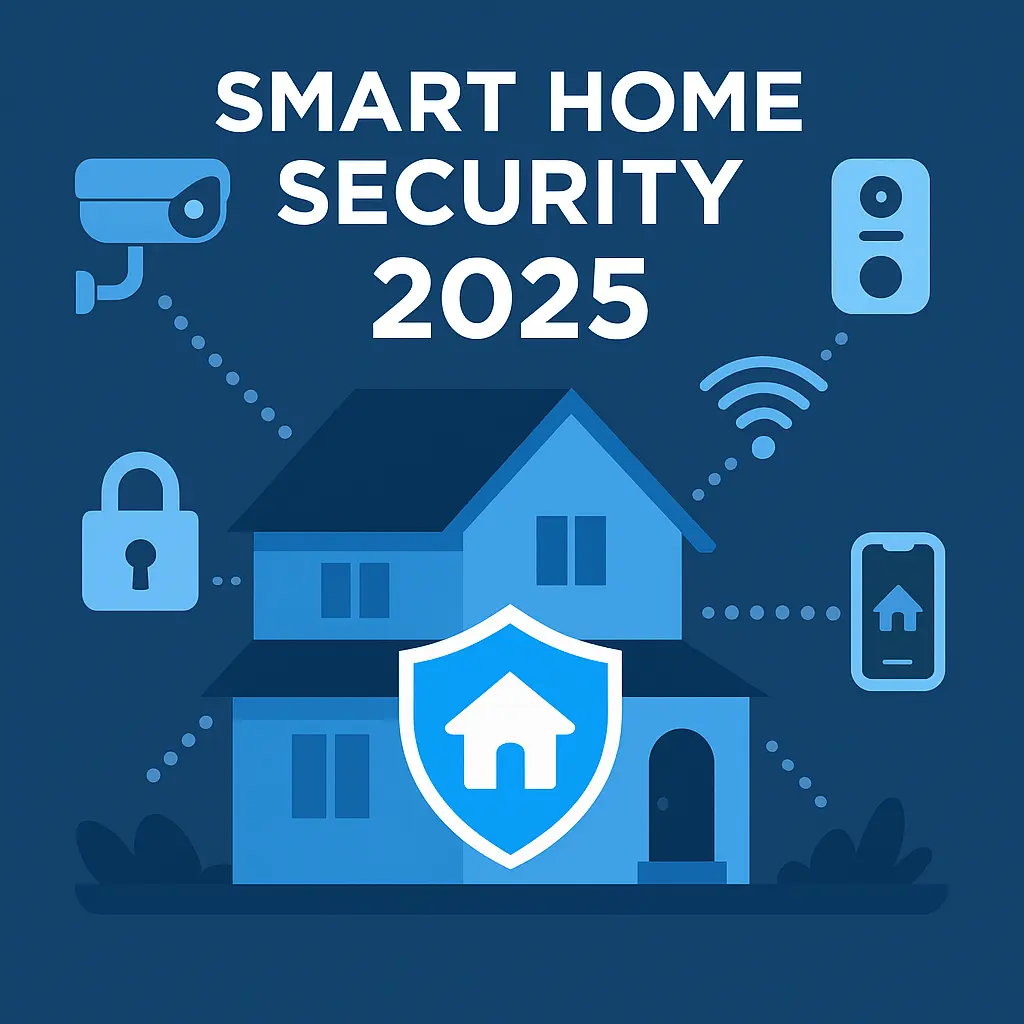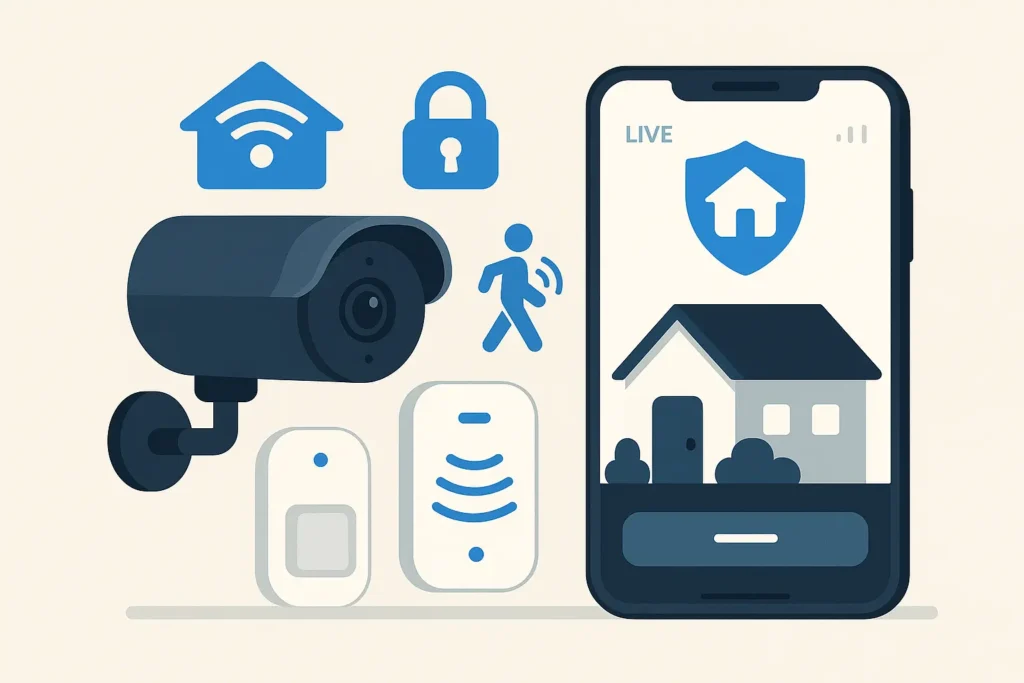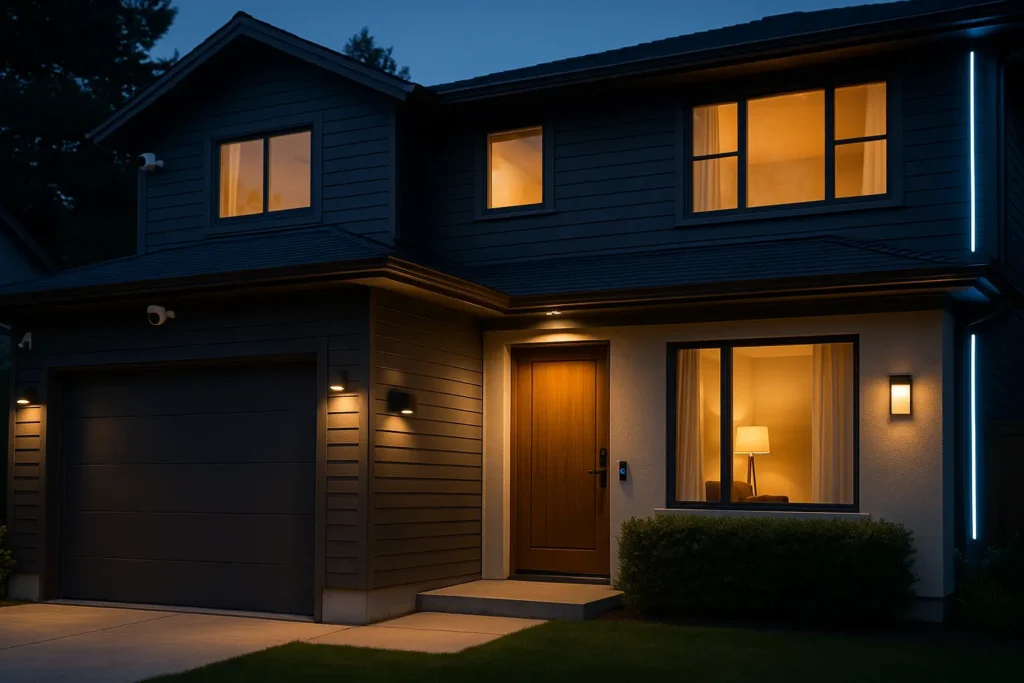
Smart home security 2025 is all about flexibility, real-time monitoring, and data privacy. Modern systems are easier than ever to install, integrate, and expand — whether you’re living in a house, apartment, or rental property.. But for many homeowners and renters, the world of smart home security still feels overwhelming.
This guide breaks down the basics of building a connected and secure smart home. You’ll learn about key device types, how they work together, and how to avoid common mistakes when setting up your system.
What Is Smart Home Security?
A smart home security system is a network of internet-connected devices designed to monitor, alert, and protect your home in real-time. Unlike traditional alarm systems, smart devices can be controlled remotely using a mobile app or voice assistant, giving you full visibility and control — whether you’re home or away.
These systems are modular and scalable. You can start with a single smart doorbell or camera and expand gradually into a complete setup that includes locks, sensors, and automation.
Core Devices in a Smart Home Security 2025

Here are the essential building blocks of a smart home security 2025:
1. Smart Cameras
These are the eyes of your entire smart security setup. Positioned both indoors and outdoors, smart cameras offer continuous 24/7 surveillance, two-way audio, motion alerts, and even facial or package recognition via AI. Many modern cameras now feature 4K Ultra HD resolution, night vision (infrared or spotlight), and flexible storage — either via cloud subscriptions or secure local options like SD cards or encrypted hubs. Look for models that integrate with Google Assistant, Alexa, or Apple HomeKit for seamless control.
Tip: Prioritize cameras with customizable motion zones and real-time notifications to avoid false alerts.
2. Smart Doorbells
Video doorbells act as both a camera and intercom at your home’s main entry point. They allow you to see, hear, and speak to visitors — whether you’re in the house or away. Many models now offer AI detection for people vs. general motion, real-time two-way audio, and integration with smart locks to remotely let in deliveries or guests.
Ideal for: Monitoring package deliveries, deterring suspicious behavior, and creating a visible security presence at your front door.
3. Smart Locks
Forget about hiding a spare key under the mat. Smart locks let you control and monitor entry to your home via smartphone, fingerprint scanner, or PIN code. You can create temporary codes for guests, track who entered and when, and even automate locking based on your geolocation.
Modern smart locks can be set to automatically lock when you leave and unlock when you return — boosting both convenience and security. They’re often compatible with smart assistants and apps, allowing voice commands like “lock the front door.”
Bonus: Choose models that support two-factor authentication for maximum digital security.
4. Window & Door Sensors
These magnetic contact sensors are simple yet effective. Installed on doors, windows, and garage openings, they trigger an alert when the circuit is broken (i.e., when the entry point is opened). Some systems even integrate these alerts with sirens or push notifications.
They are among the most affordable components of a smart home security 2025 setup and can be installed in minutes without any drilling. Advanced versions offer tamper detection and battery-level alerts.
Recommended for: Apartments, rental properties, or low-cost expansion of larger systems.
5. Motion Detectors
Motion sensors use infrared, microwave, or AI vision technology to detect movement in specific zones. Placed in entryways, stairwells, and living areas, they can activate lights, trigger cameras, or send alerts when unexpected motion is detected.
Newer models include pet immunity, meaning they can ignore pets under a certain weight, reducing false alarms. Some even distinguish between types of motion — such as walking humans versus swaying plants.
Best practice: Combine motion sensors with lights or sirens for maximum deterrence.
6. Smart Hubs & Mobile Apps
The smart hub is the brain of your entire home security system. Devices like the Amazon Echo Show, Google Nest Hub, or dedicated hubs (like Eufy HomeBase) consolidate control into one platform. These systems often allow you to create automation routines like “if door opens, turn on hallway light and start recording.”
Mobile apps, on the other hand, offer real-time access to cameras, locks, and notifications from anywhere. In 2025, most hubs support the Matter protocol, which ensures better compatibility between brands.
What to look for: A hub or app that supports scheduling, voice control, and secure remote access.
Why Smart Home Security Is Worth It in 2025
One of the biggest reasons people choose smart home security 2025 systems is the flexibility to monitor, automate, and protect everything from their smartphone.

No Monthly Fees (if you choose local storage)
Brands like Eufy and Wyze offer solutions with no subscription required.
24/7 Monitoring from Anywhere
Whether you’re on vacation or at work, you can check in on your property in real-time.
Faster Response Times
Motion alerts and sound detection allow you to act immediately — call emergency services, speak through your device, or activate a siren.
Custom Automation
Create rules like “Turn on porch lights if motion is detected after 10 PM.”
Lower Insurance Premiums
Many insurance companies offer discounts if your home includes certified smart security systems.
One of the biggest advantages of choosing a smart home security 2025 setup is the ability to control everything through one app — no matter where you are.
Common Mistakes to Avoid When Setting Up Smart Security
1. Placing Cameras Too High or Too Wide
If your camera isn’t positioned correctly, it may miss key activity or create blind spots. Focus on entry points — doors, driveways, windows.
2. Ignoring Wi-Fi Strength
All devices depend on strong, stable Wi-Fi. Use extenders or mesh systems for full home coverage.
3. Choosing Cloud-Only Cameras
While cloud storage is convenient, relying on it exclusively can be risky if your internet goes down. Consider models that also offer local storage.
4. Not Setting Up Motion Zones
Without setting custom zones, you’ll receive too many false alerts — from trees, traffic, or pets.
5. Skipping Software Updates
Always keep your device firmware up to date. Updates often fix security flaws and improve performance.
Starter Setup: What You Need to Begin
If you’re building your first system in 2025, here’s a basic smart security setup that offers excellent coverage:
- 1× Video Doorbell
- 2× Outdoor Smart Cameras (front and back)
- 1× Smart Lock (main door)
- 4× Contact Sensors (windows and back door)
- 1× Mobile App or Hub Controller (Google, Alexa, or Apple)
Optional: motion floodlight, garage door controller, or indoor cam
Integrations and Compatibility
Make sure your devices are compatible with your ecosystem (Google Home, Amazon Alexa, or Apple HomeKit). Also look for products that support the Matter standard, which improves cross-brand communication between smart home devices. (To learn more about Matter smart home standards, visit the CSA official website — the alliance behind the universal smart device protocol.)
Final Thoughts on Home Protection in 2025
Smart home security systems in 2025 are more powerful and user-friendly than ever. With a bit of planning and the right combination of devices, you can protect your home without professional installation or long-term fees.
Start small, scale up, and always focus on reliable, secure devices from trusted brands. Whether you’re protecting a family home, rental, or apartment, smart security is an investment that pays off every day.
As more homes shift toward automation, investing in smart home security 2025 systems gives you long-term peace of mind and full control over your safety.
Frequently Asked Questions
Do smart home security systems really prevent break-ins?
Yes — studies show that visible cameras and smart locks significantly reduce the chance of burglary, especially when combined with motion alerts.
Can I set up a smart system myself?
Absolutely. Most modern kits are plug-and-play with intuitive app walkthroughs. No drilling or technicians required for basic setups.
Are there smart security options without monthly fees?
Yes. Brands like Eufy and Wyze offer cameras with local storage so you’re not forced to pay for cloud plans.